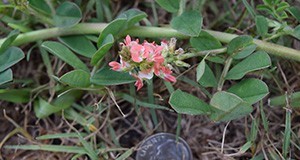Abstract
A recent rise in suspected horse poisonings has brought new attention to creeping indigo (Indigofera spicata), a toxic plant which has reportedly been in Florida for as long as 90 years. This new 5-page fact sheet covers plant description, signs of creeping indigo toxicity, and roles of creeping indigo’s toxins, as well as treatment and management. Written by Robert MacKay, Ed Jennings, Brent Sellers, Jason Ferrell, and Amanda House, and published by the UF Department of Agronomy, August 2015.
SS-AGR-395/AG399: Creeping Indigo, A Poisonous Plant of Concern in Florida Pastures (ufl.edu)
References
Morton, J. F. 1989. "Creeping indigo (Indigofera spicata Forsk.) (Fabaceae)-A hazard to herbivores in Florida." Econ. Bot. 43: 314-27. https://doi.org/10.1007/BF02858731
Emmel, M. W., and G. E. Ritchey. 1941. "The toxicity of Indigofera endecaphylla Jacq. for rabbits." J. Amer. Soc. Agron. 33: 675-77. https://doi.org/10.2134/agronj1941.00021962003300070013x
Carroll, A. G., and B. J. Swain. 1983. "Birdsville disease in the central highlands area of Queensland." Aust. Vet. J. 60: 316-17. https://doi.org/10.1111/j.1751-0813.1983.tb02827.x
Schrire, B. 2013. "A review of tribe Indigofereae (Leguminosae-Papilionoideae) in Southern Africa (including South Africa, Lesotho, Swaziland & Namibia; excluding Botswana)." S. Afr. J. Bot. 89: 281-83. https://doi.org/10.1016/j.sajb.2013.06.014
Perez, L. B., J. Li, D. D. Lantvit, L. Pan, T. N. Ninh, H. Chai, D. D. Soejarto, S. M. Swanson, D. M. Lucas, and A. D. Kinghorn. 2013. "Bioactive constituents of Indigofera spicata." J. Nat. Prod. 76: 1498-1504. https://doi.org/10.1021/np400567c
Ossedryver, S. M., G. I. Baldwin, B. M. Stone, R. A. McKenzie, A. W. van Eps, S. Murray, and M. T. Fletcher. 2013. "Indigofera spicata (creeping indigo) poisoning of three ponies." Aust. Vet. J. 91: 143-49. https://doi.org/10.1111/avj.12032
Wilson, P. G., and R. Rowe. 2008. "A revision of the Indigofereae (Fabaceae) in Australia. 2. Indigofera species with trifoliolate and alternately pinnate leaves." Telopea 12: 293-307. https://doi.org/10.7751/telopea20085819
Du Puy, D. J., J. N. Labat, and B. D. Schrire. 1993. "The separation of two previously confused species in the Indigofera spicata complex (Leguminosae: Papilionoideae)." Kew Bulletin 48: 727-33. https://doi.org/10.2307/4118850
Hopper, P. T., B. Hart, and G. W. Smith. 1971. "Prevention and treatment of Birdsville disease of horse." Aust. Vet. J. 47: 326-29. https://doi.org/10.1111/j.1751-0813.1971.tb15506.x
Lima, E. F., F. Riet-Correa, D. R. Gardner, S. S. Barros, R. M. Medeiros, M. P. Soares, and G. Riet-Correa. 2012. "Poisoning by Indigofera lespedezioides in horses." Toxicon 60: 324-28. https://doi.org/10.1016/j.toxicon.2012.04.341
Anderson, R. C., W. Majak, M. A. Rassmussen, T. R. Callaway, R. C. Beier, D. J. Nisbet, and M. J. Allison. 2005. "Toxicity and metabolism of the conjugates of 3-nitropropanol and 3-nitropropionic acid in forages poisonous to livestock." J. Agric. Food Chem. 53: 2344-50. https://doi.org/10.1021/jf040392j
Francis, K., C. Smitherman, S. F. Nishino, J. C. Spain, and G. Gadda. 2013. "The biochemistry of the metabolic poison propionate 3-nitronate and its conjugate acid, 3-nitropropionate." IUBMB Life 65: 759-68. https://doi.org/10.1002/iub.1195
Hegarty, M. P., and A. W. Pound. 1968. "Indospicine: A new hepatotoxic amino-acid from Indigofera spicata." Nature 217: 354-55. https://doi.org/10.1038/217354a0
Borer-Weir, K. E., N. J. Menzies-Gow, S. R. Bailey, P. A. Harris, and J. Elliott. 2013. "Seasonal and annual influence on insulin and cortisol results from overnight dexamethasone suppression tests in normal ponies and ponies predisposed to laminitis." Equine Vet. J. 45: 688-93. https://doi.org/10.1111/evj.12053
Túnez, I., I. Tasset, V. Pérez-De la Cruz, and A. Santamaría. 2010. "3-Nitropropionic acid as a tool to study the mechanisms involved in Huntington's Disease: Past, present and future." Molecules 15: 878-916. https://doi.org/10.3390/molecules15020878

